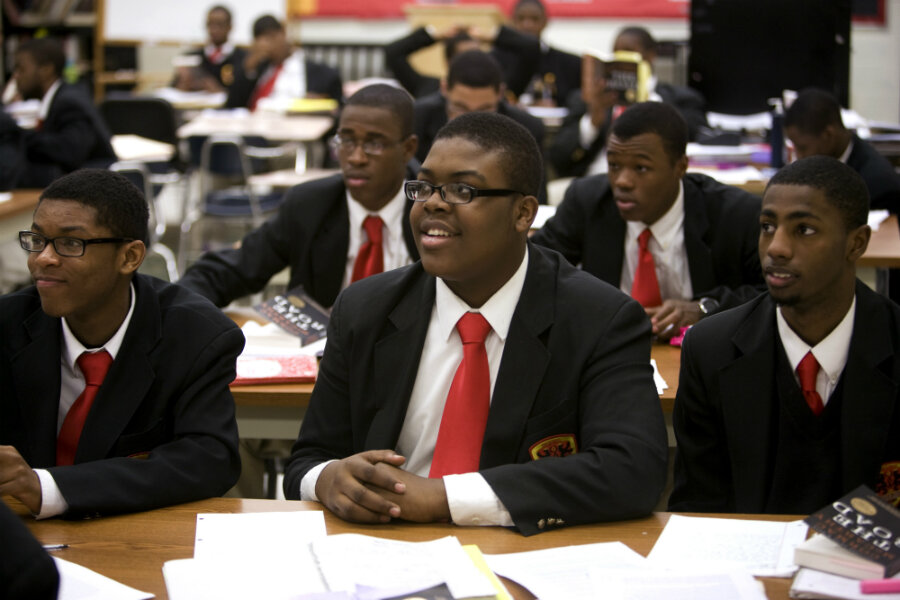A bid to close the diversity gap in young adult literature
Loading...
From the “Harry Potter” series to the “Hunger Games” trilogy, fiction geared to the tween and teen sets can regularly be found at the top of best-seller lists. But no amount of reimagining of Hermione Granger as black can erase the reality that youths of color rarely see themselves represented as the main characters of young adult novels – even though they’re the fastest-growing demographic group in the United States. The diversity of the authors writing young adult literature isn’t much better.
In a collaborative effort, the National Education Association Foundation, publishing house Lee & Low Books, and the nonprofit First Book will provide thousands of diverse books to schools and students in low-income communities. The partnership will also fund the creation of companion teacher tip sheets to ensure that students have meaningful learning experiences with the literature, and Lee & Low will publish a book by an author of color.
“This is a unique model of what can happen when publishers, nonprofits, and foundations come together to find new solutions to old problems,” Hannah Ehrlich, the marketing and publicity director at Lee & Low, wrote in an email to TakePart. The New York City-based company, which is the largest multicultural children’s book publisher in the United States, is making eight of its titles available through the partnership. To address the lack of diversity among authors, Lee & Low is also accepting manuscript submissions from unpublished authors from diverse backgrounds through Oct. 31.
“This part of the partnership came about very organically. We had already established the New Visions Award, which awards a publication contract to an unpublished author of color for a middle grade or young adult manuscript,” wrote Ehrlich. “First Book was looking for ways to encourage more publishers to take a chance on debut authors of color. We usually have only one winner, and they found a way to enable us to expand the award and bring another first-time author of color to print. Everybody wins!”
A 2015 analysis by the Cooperative Children’s Book Center at the University of Wisconsin–Madison School of Education revealed the lack of diversity among both main characters and authors. Of 3,200 children’s books produced by U.S.-based publishers that the center evaluated in 2015, only about 14 percent were about a character of color and roughly 10 percent were written by a Latino, black, Asian American or Pacific Islander, or American Indian/First Nations author.
This lack of diversity in books for kids has been a hot topic for decades. “The All-White World of Children’s Books,” a 1965 article by educator and author Nancy Larrick published in “The New York Times Saturday Review of Literature,” is one of the earliest major critiques of the issue. Youths of all backgrounds can relate to the coming-of-age struggles of characters such as Harry Potter or Katniss Everdeen. But 1990 research by The Ohio State University professor Rudine Sims Bishop found “that children need both ‘mirror’ books and ‘window’ books – that is, books in which they see themselves and books that offer a window into different experiences,” wrote Ehrlich.
Kids of color “still don’t have access to good mirror books. Mirror books make us feel, seen, appreciated, and valued by society,” Ehrlich wrote. “Without them, students are less likely to engage with books – in fact, First Book did a survey of their members and 90 percent of respondents indicated that children in their programs would be more enthusiastic readers if they had access to books with characters, stories, and images that reflect their lives and neighborhoods.”
Window books are also essential in a diverse global economy. “To be successful in navigating that world, kids need to be exposed to different perspectives and cultures from an early age. That is just our reality,” Ehrlich wrote.
• Culture and education editor Liz Dwyer has written about race, parenting, and social justice for several national publications. She was previously education editor at Good.
• This article originally appeared at TakePart, a leading source of socially relevant news, features, opinion, entertainment, and information – all focused on the issues that shape our lives.







